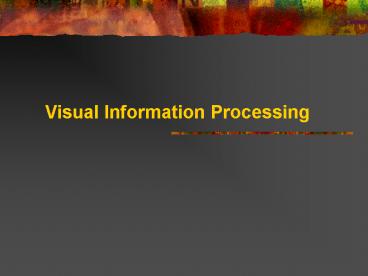Computer Graphics PowerPoint PPT Presentation
1 / 34
Title: Computer Graphics
1
Visual Information Processing
2
Human Perception V.S. Machine Perception
- Human perception
- pictorial information improvement for
- human interpretation
- Machine perception
- scene data processing for machine
- understanding.
3
(No Transcript)
4
Visual Information Processing
- Why processing visual information
- - Better perception for visualization
- - Medical imaging
- - Video images (e.g., television
commercials to feature films) - - Storage and transmission
- - Application for machine intelligence,
robotics, multimedia, graphics and - human computer interaction technology
- Topics in this course
- - Image processing fundamentals
- - Image analysis
- - Motion image processing (video)
- - Object recognition
- - Application with state-of-the-art
techniques
5
Basic Concepts
- Computer Vision
- - simulate the human visual
system, not only see the world, but also
understand the world (emulate human vision
analysis and understanding) - Image Processing
- - pre-process the image for
better see or understand - Pattern Recognition
- - classify and recognize both
image content and some other statistic data. - Computer Graphics
- - create or synthesize a
virtual image - Artificial Intelligence
- - emulate human intelligence
6
Digital Image Processing Development
- Digital image processing
- - Low-level Primitive operations (e.g.,
contrast enhancement, - sharpening in
Photoshop and Photo-Stacker) - Image-gtimage
- - Mid-level Image segmentation,
classification - image-gtattributes
(e.g., edges, objects). - - High-level Ensemble of recognized
objects - (vision make it
understood) - 1920s - Digitized newspaper picture transmitted
through submarine cable - (Londonlt-gtNew York)
- - 5 distinct brightness level
-gt 15 levels
7
Digital Image Processing Development (Contd)
- 1960s - Images from space probe (distortion
correction image transform) - 1970s - Computerized Tomography (CT) (a ring of
detectors collect the x-rays to represent a
slice) - 1980s and later
- - Computer image processing in industry,
biomedical area, military recognition, satellite
imagery for weather and environment. - - Development of signal processing.
8
Digital Image Processing Development (Contd)
left Original image right Processed image
9
Image Representation
- Image (Monochrome image / color image)
- -- f(x,y) - two-dimensional
light intensity function - -- (x,y) denote spatial
coordinates - -- the value of f at any point
(x, y) is proportional to the brightness - (or gray level or gray scale)
of the image at that point. - Example
o
y
x
10
Digital Image Representation
- Digital image
- -- an image f(x,y) that has been
discretized both in the image - coordinates and in brightness
- -- A matrix the elements of digital
array are called - pixels (picture elements, image
elements, pels) - -- In computer programming 2D array
- -- Size width - number of pixels
horizontally - height number of pixels
vertically - Example
11
Digital Image Processing System
Image Display
Computer
Hardcopy
Image Processing Software
Specialized Image Processing Hardware
(digitizer, ALU Arithmetic logic unit)
Image Sensors (optical to electronic)
12
Digital Image ProcessingFundamentals
Color Image Processing
Image Compression
Multiresolution Processing
Morphological Processing
Image Restoration
Image Segmentation
Image Enhancement
Representation Description
Knowledge Base
Image Acquisition
Object Recognition
13
Still Image vs.Motion image
- Still Image
- JPEG, JPEG2000
- All the fundamental processing
- Image synthesis
- Motion Image
- Motion analysis and detection
- Video processing and transmission (H.261, H.263,
H.264, MPEG1, 2, 4, 7, 21)
14
(No Transcript)
15
Illusion
http//www.michaelbach.de/ot/fcs_thompson-thatcher
/index.html http//members.tripod.com/RBHcognitio
ns/thatc1.htm http//www.wjh.harvard.edu/lombrozo
/home/illusions/thatcher.html
16
(No Transcript)
17
(No Transcript)
18
(No Transcript)
19
(No Transcript)
20
(No Transcript)
21
(No Transcript)
22
(No Transcript)
23
(No Transcript)
24
Image Analysis- Computer Vision
- Human Vision
- - 70 information from visual
perception - - 30 information from sound,
touch, taste, smell, - Computer Vision
- - object detection (edge,
region, texture, color,) - - camera calibration
- - 2D to 3D (shape from shading,
shape from texture, - shape from motion, )
25
Virtual Image- Image Synthesis
- Real Image and Virtual Image
- Image analysis real image
- - using computer to understand the real
world - Image Synthesis virtual image
- - using computer to create a virtual
world (computer graphics)
26
Evaluation
- Subjective and Objective Evaluation
- Subjective No better way to judge the quality of
an image than human vision - - rating
- Objective pixel-by-pixel comparison
- - mean square errors measurement
27
Recent Development
- Characteristics
- Better quality, Fast processing, Accurate
Detection, and More understanding - Architecture Parallel algorithm
- Robotics and Active vision
- Face and Gesture Recognition
- Document Image Analysis
- Texture Analysis
- Motion tracking and Analysis
- Color image analysis
28
Relevant areas
- Computer Graphics
- Image Processing
- Multimedia
- Human Computer Interaction/Interface
29
Applications
- Biomedical area (CT images)
- Military recognition
- Satellite imagery for weather and environment
- Motion video (MPEG video)
- Still image (JPEG)
- TV and Film making
30
Stereo images as seen through LCD Shutterglasses
31
(No Transcript)
32
Image Processing Programming and tools
- MS Windows Visual C
- Unix, Linux, Irix C and C
- Intel Image Processing Library.
- Image Vision Library
- Image format information (BMP, JPEG, TIF,)
33
In this Class
- You will learn
- Image Processing
Computer Vision Basics and application - You will do
- Programming
Assignments, Course Project (proposal, class
presentation, project report) - Class attendance is required.
34
References
- Text books
- (1) Digital Image
Processing (R. Gonzales) - (2) Computer Vision
(L. G. Shapiro) - Journals
- IEEE Transactions on
Pattern Analysis and Machine Intelligence - IEEE Transactions on
Image Processing - Computer vision,
Graphics and Image Processing - Pattern Recognition
- Conferences
- IEEE International
Conf. on Computer Vision and Pattern Recognition - IEEE International
Conference on Computer Vision - IEEE International
Conference on Pattern Recognition - IEEE International
Conference on Image Processing

